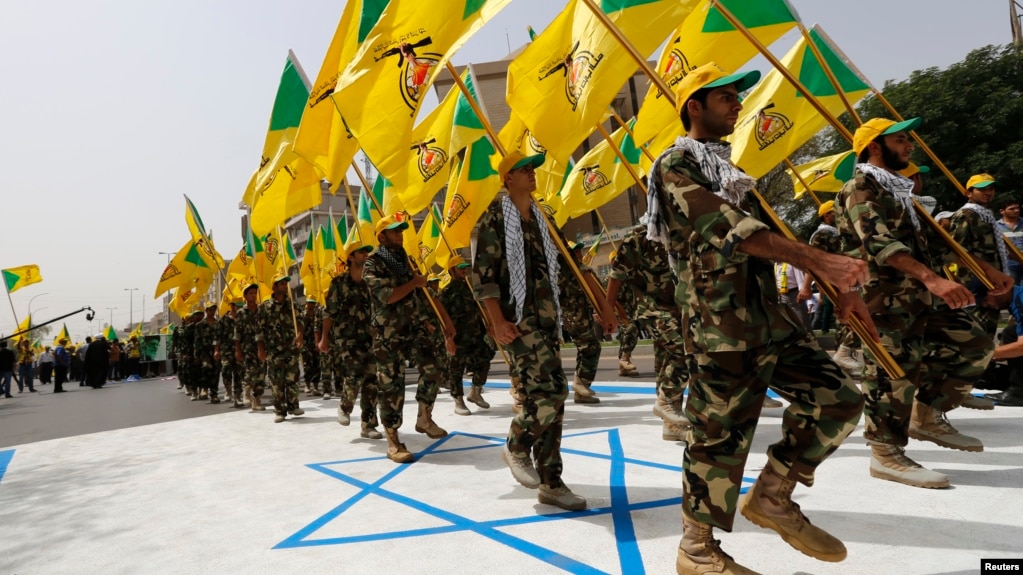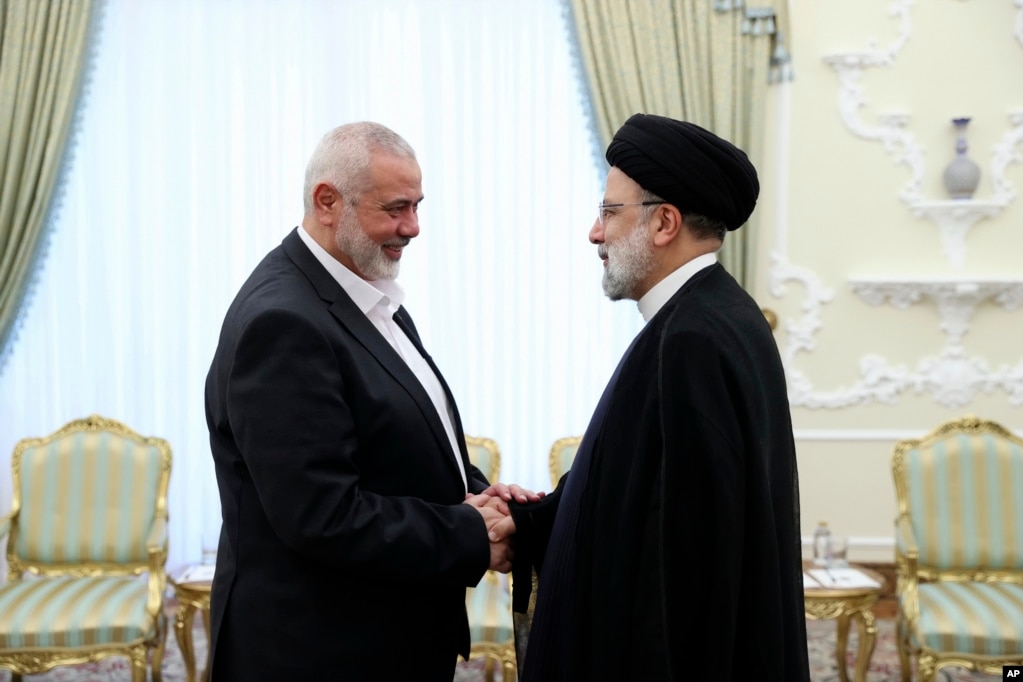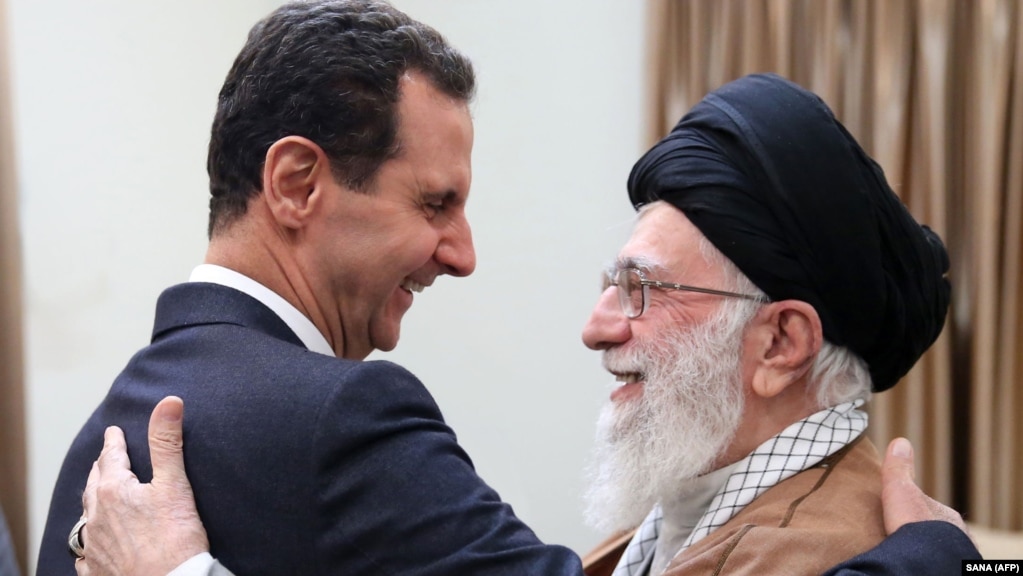
By Kian Sharifi
Iran’s so-called axis of resistance is a loose network of proxies, Tehran-backed militant groups, and an allied state actor.
The network is a key element of Tehran’s strategy of deterrence against perceived threats from the United States, regional rivals, and primarily Israel.
Active in the Palestinian Occupied Territories, Lebanon, Iraq, Syria, and Yemen, the axis gives Iran the ability to hit its enemies outside its own borders while allowing it to maintain a position of plausible deniability, experts say.
Since the Islamic Revolution in 1979, Iran has played a key role in establishing some of the groups in the axis. Other members have been co-opted by Tehran over the years.
Iran has maintained that around dozen separate groups that comprise the axis act independently.
Tehran’s level of influence over each member varies. But the goals pursued by each group broadly align with Iran’s own strategic aims, which makes direct control unnecessary, according to experts.
Lebanon’s Hizballah
Hizballah was established in 1982 in response to Israel’s invasion that year of Lebanon, which was embroiled in a devastating civil war.
The Shi’ite political and military organization was created by the Quds Force, the overseas arm of Iran’s Islamic Revolutionary Guards Corps (IRGC), the elite branch of the country’s armed forces.
Danny Citrinowicz, a research fellow at the Iran Program at the Israel-based Institute for National Security Studies, said Tehran’s aim was to unite Lebanon’s various Shi’ite political organizations and militias under one organization.
Since it was formed, Hizballah has received significant financial and political assistance from Iran, a Shi’a-majority country. That backing has made the group a major political and military force in Lebanon.
“Iran sees the organization as the main factor that will deter Israel or the U.S. from going to war against Iran and works tirelessly to build the organization’s power,” Citrinowicz said.
Hizballah has around 40,000 fighters, according to the office of the U.S. Director of National Intelligence. The State Department said Iran has armed and trained Hizballah fighters and injected hundreds of millions of dollars in the group.
The State Department in 2010 described Hizballah as “the most technically capable terrorist group in the world.”
Citrinowicz said Iran may not dictate orders to the organization but Tehran “profoundly influences” its decision-making process.
He described Hizballah, which is considered a terrorist organization by the United States and the European Union, not as a proxy but “an Iranian partner managing Tehran’s Middle East strategy.”
Led by Hassan Nasrallah, Hizballah has developed close ties with other Iranian proxies and Tehran-backed militant groups, helping to train and arm their fighters.
Citrinowicz said Tehran “almost depends” on the Lebanese group to oversee its relations with other groups in the axis of resistance.
Hamas
Hamas, designated a terrorist organization by the United States and the European Union, has had a complex relationship with Iran.
Founded in 1987 during the first Palestinian Intifada, or uprising, Hamas is an offshoot of the Palestinian arm of the Muslim Brotherhood, an Islamist political organization established in Egypt in the 1920s.
Hamas’s political chief is Ismail Haniyeh, who lives in Qatar. Its military wing, the Izz al-Din al-Qassam Brigades, is commanded by Yahya Sinwar, who is believed to be based in the Gaza Strip. Hamas is estimated to have around 20,000 fighters.
For years, Iran provided limited material support to Hamas, a Sunni militant group. Tehran ramped up its financial and military support to the Palestinian group after it gained power in the Gaza Strip in 2007.
But Tehran reduced its support to Hamas after a major disagreement over the civil war in Syria. When the conflict broke out in 2011, Iran backed the government of President Bashar al-Assad. Hamas, however, supported the rebels seeking to oust Assad.
Nevertheless, experts said the sides overcame their differences because, ultimately, they seek the same goal: Israel’s destruction.
“[But] this does not mean that Iran is deeply aware of all the actions of Hamas,” Citrinowicz said.
After Hamas militants launched a multipronged attack on Israel in October that killed around 1,200 people, mostly civilians, Iran denied it was involved in planning the assault. U.S. intelligence has indicated that Iranian leaders were surprised by Hamas’s attack.
Seyed Ali Alavi, a lecturer in Middle Eastern and Iranian Studies at SOAS University of London, said Iran’s support to Hamas is largely “confined to rhetorical and moral support and limited financial aid.” He said Qatar and Turkey, Hamas’s “organic” allies, have provided significantly more financial help to the Palestinian group.
Palestinian Islamic Jihad
With around 1,000 members, the Palestinian Islamic Jihad (PIJ) is the smaller of the two main militant groups based in the Gaza Strip and the closest to Iran.
Founded in 1981, the Sunni militant group’s creation was inspired by Iran’s Islamic Revolution two years earlier. Given Tehran’s ambition of establishing a foothold in the Palestinian Occupied Territories, Iran has provided the group with substantial financial backing and arms, experts say.
The PIJ, led by Ziyad al-Nakhalah, is designated as a terrorist organization by the United States and the European Union.
“Today, there is no Palestinian terrorist organization that is closer to Iran than this organization,” Citrinowicz said. “In fact, it relies mainly on Iran.”
Citrinowicz said there is no doubt that Tehran’s “ability to influence [the PIJ] is very significant.”
Iraqi Shi’ite Militias
Iran supports a host of Shi’ite militias in neighboring Iraq, some of which were founded by the IRGC and “defer to Iranian instructions,” said Gregory Brew, a U.S.-based Iran analyst with the Eurasia Group.
But Tehran’s influence over the militias has waned since the U.S. assassination in 2020 of Quds Force commander Qassem Soleimani, who was seen as the architect of the axis of resistance and held great influence over its members.
“The dynamic within these militias, particularly regarding their relationship with Iran, underwent a notable shift following the assassination of Qassem Soleimani,” said Hamidreza Azizi, a fellow at the German Institute for International and Security Affairs.
The U.S. drone strike that targeted Soleimani also killed Abu Mahdi al-Muhandis, the deputy head of the Popular Mobilization Forces (PMF), an umbrella organization of mostly Shi’ite Iran-backed armed groups that has been a part of the Iraqi Army since 2016.
Muhandis was also the leader of Kata’ib Hizballah, which was established in 2007 and is one of the most powerful members of the PMF. Other prominent groups in the umbrella include Asa’ib Ahl al-Haq, Harakat al-Nujaba, Kata’ib Seyyed al-Shuhada, and the Badr Organization. Kata’ib Hizballah has been designated as a terrorist entity by the United States.
Following the deaths of Soleimani and al-Muhandis, Kata’ib Hizballah and other militias “began to assert more autonomy, at times acting in ways that could potentially compromise Iran’s interests,” said Azizi.
Many of the Iran-backed groups that form the PMF are also part of the so-called Islamic Resistance in Iraq, which rose to prominence in November 2023. The group has been responsible for launching scores of attacks on U.S. troops in Iraq and Syria since Israel launched its war against Hamas in Gaza.
“It’s important to note that while several militias within the PMF operate as Iran’s proxies, this is not a universal trait across the board,” Azizi said.
Azizi said the extent of Iran’s control over the PMF can fluctuate based on the political conditions in Iraq and the individual dynamics within each militia.
The strength of each group within the PMF varies widely, with some containing as few as 100 members and others, such as Kata’ib Hizballah, boasting around 10,000 fighters.
Syrian State And Pro-Government Militias
Besides Iran, Syria is the only state that is a member of the axis of resistance.
“The relationship between Iran and the Assad regime in Syria is a strategic alliance where Iran’s influence is substantial but not absolute, indicating a balance between dependency and partnership,” said Azizi.
The decades-long alliance stems from Damascus’s support for Tehran during the devastating 1980-88 Iran-Iraq War.
When Assad’s rule was challenged during the Syrian civil war, the IRGC entered the fray in 2013 to ensure he held on to power.
Hundreds of IRGC commander and officers, who Iran refers to as “military advisers,” are believed to be present in Syria. Tehran has also built up a large network of militias, consisting mostly of Afghans and Pakistanis, in Syria.
Azizi said these militias have given Iran “a profound influence on the country’s affairs,” although not outright control over Syria.
“The Assad regime maintains its strategic independence, making decisions that serve its national interests and those of its allies,” he said.
The Fatemiyun Brigade, comprised of Afghan fighters, and the Zainabiyun Brigade, which is made up of Pakistani fighters, make up the bulk of Iran’s proxies in Syria.
“They are essentially units in the IRGC, under direct control,” said Brew.
The Afghan and Pakistani militias played a key role in fighting rebel groups opposed to Assad during the civil war. There have been reports that Iran has not only granted citizenship to Afghan fighters and their families but also facilitated Syrian citizenship for them.
The Fatemiyun Brigade, the larger of the two, is believed to have several thousand fighters in Syria. The Zainabiyun Brigade is estimated to have less than 1,000 fighters.
Yemen’s Huthi Rebels
The Huthis first emerged as a movement in the 1980s in response to the growing religious influence of neighboring Saudi Arabia, a Sunni kingdom.
In 2015, the Shi’ite militia toppled the internationally recognized, Saudi-backed government of Yemen. That triggered a brutal, yearslong Saudi-led war against the rebels.
With an estimated 200,000 fighters, the Huthis control most of the northwest of the country, including the capital, Sanaa, and are in charge of much of the Red Sea coast.
The Huthis’ disdain for Saudi Arabia, Iran’s regional foe, and Israel made it a natural ally of Tehran, experts say. But it was only around 2015 that Iran began providing the group with training through the Quds Force and Hizballah. Tehran has also supplied weapons to the group, though shipments are regularly intercepted by the United States.
“The Huthis…appear to have considerable autonomy and Tehran exercises only limited control, though there does appear to be [a] clear alignment of interests,” said Brew.
Since Israel launched its war in Gaza, the Huthis have attacked international commercial vessels in the Red Sea and fired ballistic missiles at several U.S. warships.
In response, the United States and its allies have launched air strikes against the Huthis’ military infrastructure. Washington has also re-designated the Huthis as a terrorist organization.




